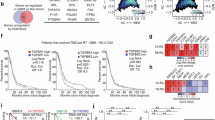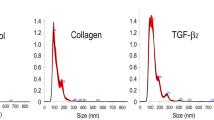Abstract
Transforming growth factor beta 1 (TGF-β1) is the most potent inhibitor of myogenic differentiation (MyoD) of rhabdomyosarcoma (RMS); however, the underlying mechanisms of this inhibition remain unclear. In this study, we identified novel TGF-β1-related microRNAs (miRNAs); among these, miR-450b-5p is significantly regulated by TGF-β1. We provide evidence that TGF-β1 exerts it function by suppressing miR-450b-5p. Both in cultured cells and tumor implants, miR-450b-5p significantly arrested the growth of RMS and promoted its MyoD. Utilizing a bioinformatics approach, we identified miR-450b-5p target mRNAs. Among these candidates, only the expression of ecto-NOX disulfide-thiol exchanger 2 (ENOX2) and paired box 9 (PAX9) was augmented by miR-450b-5p knockdown examined by western blot; the engineered inhibition antagonized TGF-β1-mediated differentiation inhibition. Furthermore, we found that the Smad3 and Smad4 pathways, but not Smad2, are the principal mediator of TGF-β1 suppression of miR-450b-5p. Taken together, these results suggest that disrupting the TGF-β1 suppression of miR-450b-5p, or knockdown of ENOX2 and PAX9, are effective approaches in inducing RMS MyoD.
This is a preview of subscription content, access via your institution
Access options
Subscribe to this journal
Receive 50 print issues and online access
$259.00 per year
only $5.18 per issue
Buy this article
- Purchase on SpringerLink
- Instant access to full article PDF
Prices may be subject to local taxes which are calculated during checkout







Similar content being viewed by others
Accession codes
References
Sebire NJ, Malone M . Myogenin and MyoD1 expression in paediatric rhabdomyosarcomas. J Clin Pathol 2003; 56: 412–416.
Tapscott SJ, Thayer MJ, Weintraub H . Deficiency in rhabdomyosarcomas of a factor required for MyoD activity and myogenesis. Science 1993; 259: 1450–1453.
Mishra PJ, Merlino G . MicroRNA reexpression as differentiation therapy in cancer. J Clin Invest 2009; 119: 2119–2123.
Wurdinger T, Costa FF . Molecular therapy in the microRNA era. Pharmacogenomics J 2007; 7: 297–304.
Wang V, Wu W . MicroRNA-based therapeutics for cancer. BioDrugs 2009; 23: 15–23.
Li Y, Foster W, Deasy BM, Chan Y, Prisk V, Tang Y et al. Transforming growth factor-beta1 induces the differentiation of myogenic cells into fibrotic cells in injured skeletal muscle: a key event in muscle fibrogenesis. Am J Pathol 2004; 164: 1007–1019.
Sun Q, Zhang Y, Yang G, Chen X, Cao G, Wang J et al. Transforming growth factor-beta-regulated miR-24 promotes skeletal muscle differentiation. Nucleic Acids Res 2008; 36: 2690–2699.
Wang SL, Yao HH, Guo LL, Dong L, Li SG, Gu YP et al. Selection of optimal sites for TGFB1 gene silencing by chitosan-TPP nanoparticle-mediated delivery of shRNA. Cancer Genet Cytogenet 2009; 190: 8–14.
Wang S, Guo L, Dong L, Li S, Zhang J, Sun M . TGF-beta1 signal pathway may contribute to rhabdomyosarcoma development by inhibiting differentiation. Cancer Sci 2010; 101: 1108–1116.
Ye L, Zhang HY, Wang H, Yang GH, Bu H, Zhang L et al. Effects of transforming growth factor beta 1 on the growth of rhabdomyosarcoma cell line RD. Chin Med J (Engl) 2005; 118: 678–686.
Davis BN, Hilyard AC, Lagna G, Hata A . SMAD proteins control DROSHA-mediated microRNA maturation. Nature 2008; 454: 56–61.
Kong W, Yang H, He L, Zhao JJ, Coppola D, Dalton WS et al. MicroRNA-155 is regulated by the transforming growth factor beta/Smad pathway and contributes to epithelial cell plasticity by targeting RhoA. Mol Cell Biol 2008; 28: 6773–6784.
Wang B, Hsu SH, Majumder S, Kutay H, Huang W, Jacob ST et al. TGFbeta-mediated upregulation of hepatic miR-181b promotes hepatocarcinogenesis by targeting TIMP3. Oncogene 2010; 29: 1787–1797.
Shoji Y, Saegusa M, Takano Y, Ohbu M, Okayasu I . Correlation of apoptosis with tumour cell differentiation, progression, and HPV infection in cervical carcinoma. J Clin Pathol 1996; 49: 134–138.
Liu D, Black BL, Derynck R . TGF-beta inhibits muscle differentiation through functional repression of myogenic transcription factors by Smad3. Genes Dev 2001; 15: 2950–2966.
Massague J . TGFbeta in cancer. Cell 2008; 134: 215–230.
Bouche M, Canipari R, Melchionna R, Willems D, Senni MI, Molinaro M . TGF-beta autocrine loop regulates cell growth and myogenic differentiation in human rhabdomyosarcoma cells. FASEB J 2000; 14: 1147–1158.
Calin GA, Croce CM . MicroRNA signatures in human cancers. Nat Rev Cancer 2006; 6: 857–866.
Kumar MS, Lu J, Mercer KL, Golub TR, Jacks T . Impaired microRNA processing enhances cellular transformation and tumorigenesis. Nat Genet 2007; 39: 673–677.
Yamagata K, Fujiyama S, Ito S, Ueda T, Murata T, Naitou M et al. Maturation of microRNA is hormonally regulated by a nuclear receptor. Mol Cell 2009; 36: 340–347.
Suzuki HI, Yamagata K, Sugimoto K, Iwamoto T, Kato S, Miyazono K . Modulation of microRNA processing by p53. Nature 2009; 460: 529–533.
Suzuki HI, Miyazono K . Emerging complexity of microRNA generation cascades. J Biochem 2011; 149: 15–25.
Bartel DP . MicroRNAs: target recognition and regulatory functions. Cell 2009; 136: 215–233.
Liu NC, Hsieh PF, Hsieh MK, Zeng ZM, Cheng HL, Liao JW et al. Capsaicin-mediated tNOX (ENOX2) up-regulation enhances cell proliferation and migration in vitro and in vivo. J Agric Food Chem 2012; 60: 2758–2765.
Rodrigo I, Hill RE, Balling R, Munsterberg A, Imai K . Pax1 and Pax9 activate Bapx1 to induce chondrogenic differentiation in the sclerotome. Development 2003; 130: 473–482.
Zeng ZM, Chuang SM, Chang TC, Hong CW, Chou JC, Yang JJ et al. Phosphorylation of serine-504 of tNOX (ENOX2) modulates cell proliferation and migration in cancer cells. Exp Cell Res 2012; 318: 1759–1766.
Hatley ME, Tang W, Garcia MR, Finkelstein D, Millay DP, Liu N et al. A mouse model of rhabdomyosarcoma originating from the adipocyte lineage. Cancer Cell 2012; 22: 536–546.
Liu D, Kang JS, Derynck R . TGF-beta-activated Smad3 represses MEF2-dependent transcription in myogenic differentiation. EMBO J 2004; 23: 1557–1566.
Ge X, McFarlane C, Vajjala A, Lokireddy S, Ng ZH, Tan CK et al. Smad3 signaling is required for satellite cell function and myogenic differentiation of myoblasts. Cell Res 2011; 21: 1591–1604.
Segev H, Fishman B, Ziskind A, Shulman M, Itskovitz-Eldor J . Differentiation of human embryonic stem cells into insulin-producing clusters. Stem Cells 2004; 22: 265–274.
Yang Z, MacQuarrie KL, Analau E, Tyler AE, Dilworth FJ, Cao Y et al. MyoD and E-protein heterodimers switch rhabdomyosarcoma cells from an arrested myoblast phase to a differentiated state. Genes Dev 2009; 23: 694–707.
Guo H, Zhang HY, Wang SL, Ye L, Yang GH, Bu H . Smad4 and ERK2 stimulated by transforming growth factor beta1 in rhabdomyosarcoma. Chin Med J (Engl) 2007; 120: 515–521.
Chen C, Ridzon DA, Broomer AJ, Zhou Z, Lee DH, Nguyen JT et al. Real-time quantification of microRNAs by stem-loop RT-PCR. Nucleic Acids Res 2005; 33: e179.
Schmittgen TD, Lee EJ, Jiang J, Sarkar A, Yang L, Elton TS et al. Real-time PCR quantification of precursor and mature microRNA. Methods 2008; 44: 31–38.
Cheng AM, Byrom MW, Shelton J, Ford LP . Antisense inhibition of human miRNAs and indications for an involvement of miRNA in cell growth and apoptosis. Nucleic Acids Res 2005; 33: 1290–1297.
Acknowledgements
We would like to thank the West China Hospital of Sichuan University for providing us with the tumor specimens. This work was supported partially by the Chinese Nature Science Foundation (81072186, 81272738), Jiangsu Provincial Nature Science Foundation (SBK20110743), Jiangsu Provincial Higher Institution Nature Science Foundation (10KJB320018), Suzhou Applied Basic Research Programs (SYS201207), and Sponsorship of Jiangsu Overseas Research and Training Program for University Prominent Young and Middle-aged Teachers and Presidents.
Author information
Authors and Affiliations
Corresponding authors
Ethics declarations
Competing interests
The authors declare no conflict of interest.
Additional information
Supplementary Information accompanies this paper on the Oncogene website
Supplementary information
Rights and permissions
About this article
Cite this article
Sun, M., Li, J., Guo, L. et al. TGF-β1 suppression of microRNA-450b-5p expression: a novel mechanism for blocking myogenic differentiation of rhabdomyosarcoma. Oncogene 33, 2075–2086 (2014). https://doi.org/10.1038/onc.2013.165
Received:
Revised:
Accepted:
Published:
Issue date:
DOI: https://doi.org/10.1038/onc.2013.165
Keywords
This article is cited by
-
LncRNA Hoxaas3 promotes lung fibroblast activation and fibrosis by targeting miR-450b-5p to regulate Runx1
Cell Death & Disease (2020)
-
miR-450b-5p loss mediated KIF26B activation promoted hepatocellular carcinoma progression by activating PI3K/AKT pathway
Cancer Cell International (2019)
-
miRNA signatures in childhood sarcomas and their clinical implications
Clinical and Translational Oncology (2019)
-
Plasma Exosomal miR-450b-5p as a Possible Biomarker and Therapeutic Target for Transient Ischaemic Attacks in Rats
Journal of Molecular Neuroscience (2019)
-
MiR-27a-5p Increases Steer Fat Deposition Partly by Targeting Calcium-sensing Receptor (CASR)
Scientific Reports (2018)



